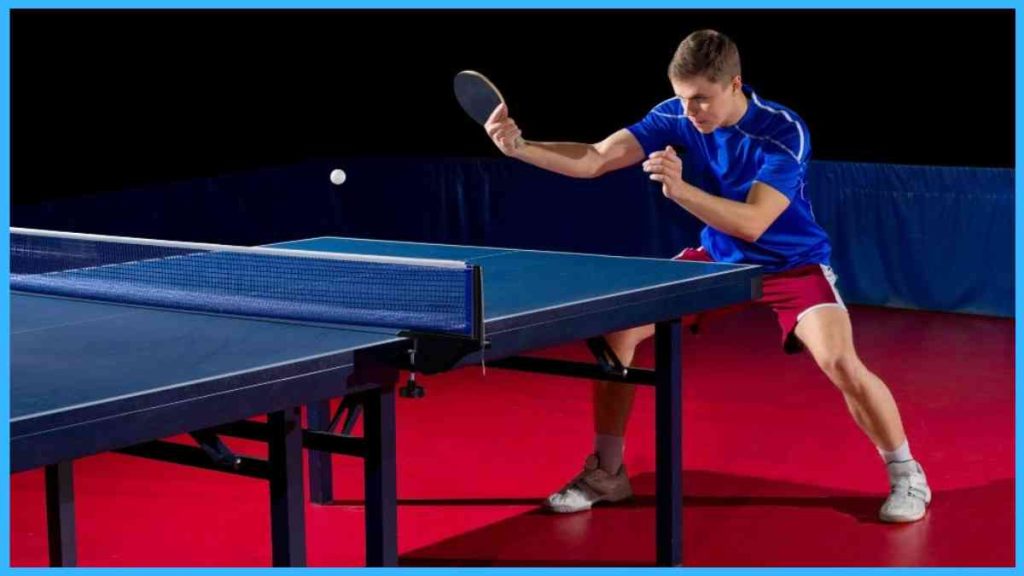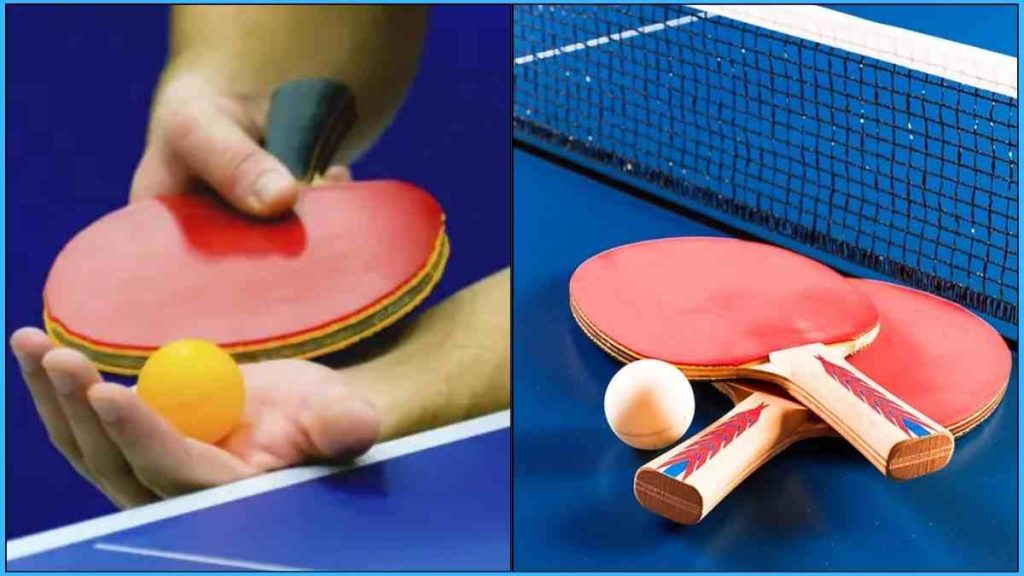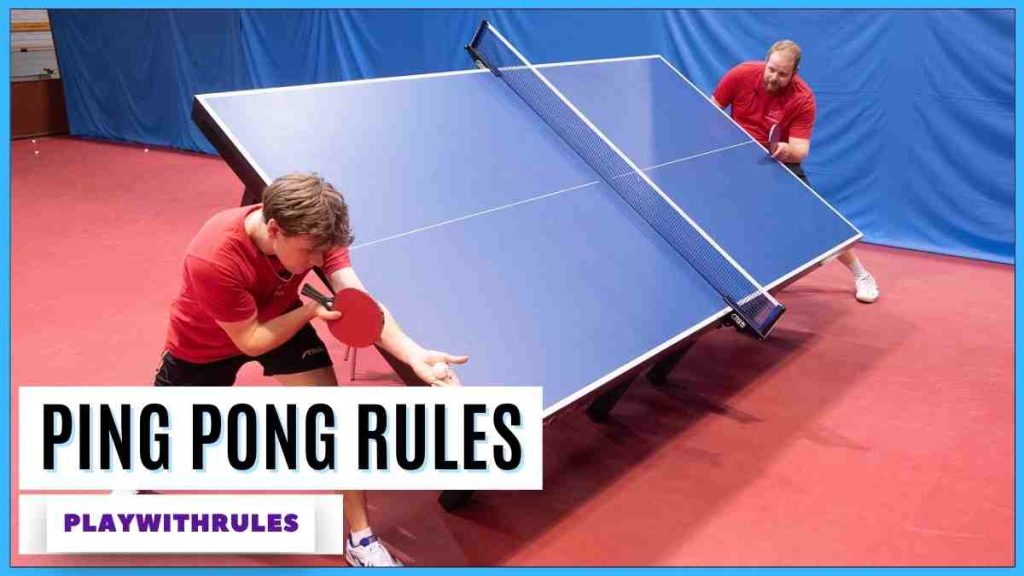Ping Pong Rules: What a fascinating game Ping Pong is—fast-paced, energetic, and calculated. It is almost like watching a well-choreographed dance between competitors. Ping Pong, also known as Table Tennis, is one of the most well-liked and popular sports on earth. Hence, today, we will be talking about the rules of ping pong.
Most people have a basic understanding of the game’s general rules—start with the service and then play the ball between yourself and your opponent to make them miss. Does this sound like your game? Then, let’s quickly run through all the rules of Ping-Pong!
Table of Contents
How To Play Ping Pong?
Ping Pong can either be played as a singles sport or as doubles. Irrespective of how many players are playing the game at one time, the ping pong rules, the nature of the game, and its mechanics remain the same. Players compete with each other from opposite sides of the table. They rally a small Ping Pong ball across the board using a paddle.
The player who misses the ball or fails to keep the rally going loses, and the other player scores a point. That is the gist of the game. Now, let’s dive into the details and unravel the hows and whys.
Objective
The objective of each player is to win a rally after a legal serve by playing the ball into the other player’s half of the board. For example, if you are tied in a rally with an opponent and they cannot back the ball to you at some point, you win a point, and they do not. The ultimate objective is to win the game, and to do that, you need to win 3 game sets.

Ping Pong Rules
Now, get into the thick of it – how to play ping pong and the game’s rules. There is only a little to it at a glance, except not losing a point, legal serves, and shots. However, there are nuances to the most basic rules of ping pong. Read and learn the rules carefully to know exactly what to do and avoid when you find yourself in a Ping Pong match.
General Rules Of Ping Pong
First, we will discuss the game’s general rules – how many scores you need to win, how many rounds, serving correctly, etc. The general rules of ping pong are as follows:
- All ping pong games are played to 11 points (not the old 21 points anymore).
- A coin toss is done to decide who serves first or who picks the side of the table.
- According to the rules of ping pong, serves are alternated between players after 2 points are scored until the end of the game or until the score reaches a deuce (let’s say 10-10).
- The first player to serve in the first game also becomes the first serve in the following game.
- At the end of each game, players exchange the side of the table.
- If both players cannot agree on a call, the final say rests with the player to whom the ball was hit or directed. This is not a hard and fast rule but a generally accepted convention for when there is no moderator or umpire.
- Players can call ‘let’ and play the point again if there is a disturbance.
- According to the official ping pong rules, you can switch your playing hand in the middle of the game if you want to.
Service
- According to ping pong service rules, a player must have the ball in an open palm before hitting it with their paddle to perform a legal service. This ensures that the opponent has clear visibility of the ball.
- The ball must be tossed at least 6 inches in the air and struck for service on its way down.
- If the served ball hits the net and falls back on your end of the table, then you do not score a point – it is lost. However, if the ball touches the net and lands on the opponent’s side of the table, the serve is called ‘Net.’ In such a case, the player is given a chance to re-serve. There is no limit to the number of ‘Net’ serves a player can do consecutively.
- As per ping pong service rules, when serving, your ball must bounce on your side of the table only once before bouncing on the opponent’s side.
- After the service, once the rally begins, all shots must cross over to the opponent’s side of the table without bouncing on your side first.
- If a ball grazes the net or the net supports, it is still in play. It is only a fault when the ball hits the net and doesn’t go over it or gets stuck.
- Returns that strike anywhere other than the net or the opponent’s area of the table are considered out of play.
- A ball striking the board’s top edge is considered ‘good.’ However, if it touches or hits against the side of the table, it isn’t considered ‘good’ and the point is lost.
- Rebounds or shots that strike against any part of the paddle or the paddle hand are considered legal and good, per ping pong service rules.
Singles
In singles ping pong, you are up against another player. Here are the rules of Singles matches in ping pong:
- Players can serve on any side of the table as long as it is legal. They do not have to cross-serve.
- There are no second serves.
Doubles
In Doubles ping pong, you play in teams. In other words, you and your teammate play against two opponent players in a team. The doubles game has a few key differences in rules that you must be aware of. They are as follows:
- The serve must be diagonal (cross-court) – that’s the rules of ping pong for a doubles game! In other words, you must serve from the right side of your table to the right side of your opponent team’s table. The white line in the middle of the court can be used for reference during service.
- The team that serves first decides which player will serve first. Let’s assume that A1 and A2 are a team and B1 and B2 are a team. If team A is going first and A1 is serving, then after two services, B1 will serve for two services. This will be followed by A2 (two services) and B2 (two services). The process is then repeated until the game is over.
- In doubles, players must follow the alternate hitting-the-ball method. This is called the rotation rule. Let’s say A1 serves to B1, who rallies it back. The next player to hit the shot must be A2. A2’s shot must be returned by B2, whose shot must be struck by A1, and so on.
Fouls
- As per the ping pong rules, players cannot hit the ball twice consecutively with their paddle or any part of their body. This is called a double hit, and it is not allowed.
- If a player obstructs a ball before it lands on their side of the table, they lose the point. The point is played again if the ball is obstructed while returning a rally.
- Returns or rebounds that strike against both hands and the racket, a racket that is not held, or a hand that is not holding the racket lead to a loss of the point.
- Players are not allowed to touch the table with their non-playing hands at any point during the match or when the game is on. Doing so will result in a point forfeiture. This also extends to moving the table during a match or touching the net with any part of their body.
- The ping pong rules strictly state that players cannot hit the ball with any part of their body other than the paddle and the racket hand.
- The ball cannot bounce more than once on your side of the table.
- You cannot hit a ball before it has bounced once on your side of the table.

Scoring & Winning
You score points for every shot you hit that the opponent team/player fails to return. The player with the higher points is the leading player. A player who has won 11 points and is at least 2 points ahead of their opponent wins the set. For example, Team A has 11 points, and Team B has 9. In this case, team A is the clear winner of the set. A player or team must win 3 sets faster than their opponents to win the game.
Equipment
To play ping-pong, you need a ball, paddles for each player, a table with the right demarcations, and a net that runs along the width of the court, dividing it into two halves. The dimensions of the table are 247cm(L) X 152.5cm(W) X 76 cm(H). According to the rules of ping pong, the net that runs across the middle of the table is 15.25cm above the table surface.
Important Terms
Before moving on to the next part, you must understand two important terms. They are as follows:
- Deuce – A deuce is when the scores are tied between two players or teams at 10-10. To win a set, a player or a team needs a 2-point lead to win, and the score to win is 11. In case of a deuce, the first team or player to secure a 2-point lead wins the set.
- Out of turn – In a doubles game, players must alternate serving the ball and hitting the ball as well. If a player hits the ball out of turn, they lose a point.
Tips & Strategies
In this section of the article, we have curated some insightful and supportive tips and strategies that will drastically improve your ping-pong game. Read on:
- Working on footwork and reflexes – Ping pong is a game where your reflexes significantly decide how well you fare. The quicker you are, the better you will be at ping pong. However, being swift means being light on your feet and your hands. Improve your hand-eye coordination to work on your reflexes while staying light on your feet. This will allow you to move quickly and position yourself better for more powerful and precise shots.
- Master the serves—If you can gain a point on a serve, you can take the lead. Practice different serves, such as sidespin, backspin, topspin, etc. This will make it difficult for your opponent to return the serve, and you will gain a point.
- Returns – Most players need to work on returns, and that is where they lose out on valuable points. Practice returning the most difficult serves in a way that makes it difficult for your opponent to return your rally.
- Mix It Up—Keep mixing up the shots—the style, the power, the positioning, etc. This will keep your opponent guessing and get inside their head. If they cannot predict your game or moves, your chances of winning that set will increase multiplefold.
- Torso Power—If you use just your arms and shoulders to pack all the power you have behind your shots, you will soon tire yourself out. The opponent will then be able to take advantage easily. That is why, to avoid this, use your upper and lower body to generate power. Use your back leg to generate power and rotate your torso when hitting. This will take the load off your shoulders and hands, and you will be able to rally longer.
Did You Know?
- Originally, Ping Pong was the name of a brand of Table Tennis equipment, and it was trademarked in the 1900s by firm J. Jaques & Son Ltd.
- The game established international diplomacy between the United States and China in the 1970s. In 1971, an American ping pong team was invited to China for a match.
- A standard ping-pong ball is made of ABS plastic and weighs about 2.7 grams. It is designed to be light so that the air can affect its direction, allowing for spin shots and more.
- Ping-pong robots have existed since the 1980s and have helped players train for matches. These robots can emulate different types of shots. Some advanced robots can mimic the play style of some of the world’s top players.
FAQs
How many players can play Ping Pong?
Official ping pong rules suggest that the game can be played as either a singles game (2 players) or a doubles game (4 players).
What are the different racquet holding positions?
There are two ways to hold a ping-pong racquet: the pen-holding grip and the shake-hand grip. Each grip has its advantages. For example, the pen grip is popular in Asia, while the shake-hand grip is more prevalent in Western countries.
How do you spin a ball in Ping Pong?
It takes a lot of practice to master the different spin shots in ping pong. It requires the proper brushing technique, the right speed, and attack on the ball at the right spot.
Is Ping Pong an Olympic sport?
Yes, Ping Pong, also known as Table Tennis, is an Olympic sport. It was introduced at the 1988 Seoul Olympic Games.
Ready to up your game and surprise everyone? Learning the Ping Pong Rules is the first step to becoming a pro at the game, and with the above information, you can do your job. Now, all you have to do is practice and play. Whether you are playing for fun or looking to dominate your opponent, having a deeper understanding of the game and its rules will give you a competitive edge like no other. Now, go out and experiment with the game! Don’t forget to stay with Play With Rules to learn more new games.
READ MORE:- Sequence Rules: How To Play, Setup, Winning

